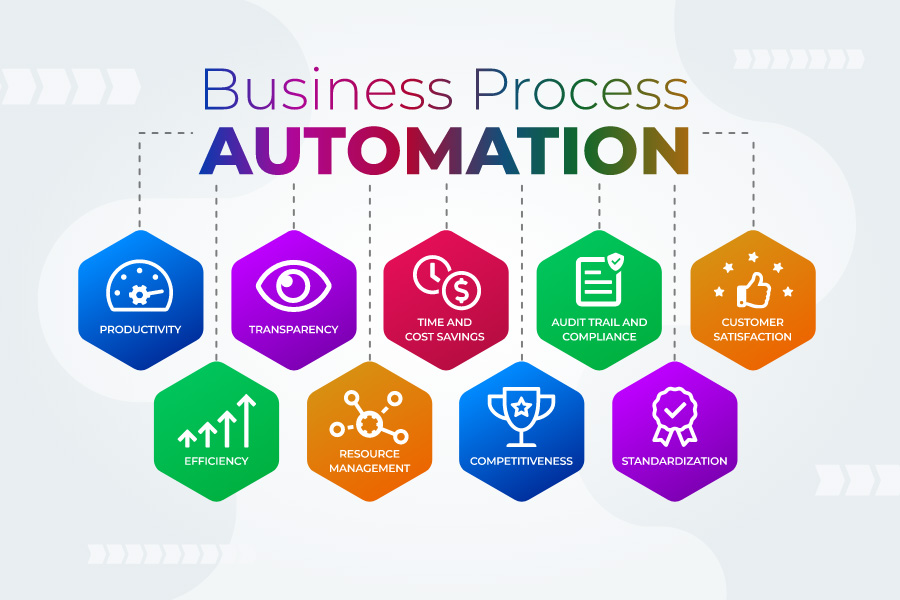
Introduction
In today’s fast-paced and highly competitive business landscape, efficiency and productivity are paramount. To stay ahead, organizations need to optimize their operations and eliminate time-consuming manual tasks. This is where business process automation (BPA) comes into play. BPA enables companies to streamline their workflows, reduce errors, and enhance overall productivity by leveraging technology to automate repetitive and mundane processes. In this blog, we will explore the benefits and implementation of business process automation, empowering businesses to embrace this transformative strategy.
What is Business Process Automation?
Business process automation involves the use of technology to automate repetitive tasks, data management, and decision-making processes within an organization. It aims to replace manual efforts with automated systems, freeing up valuable time and resources for more strategic and value-added activities. BPA can be applied to various departments and processes, including finance, human resources, customer service, sales, and supply chain management.
Benefits of Business Process Automation
- Increased Efficiency: By automating routine tasks, organizations can significantly reduce the time and effort required to complete them. BPA enables streamlined workflows, eliminating bottlenecks and reducing the risk of errors. Employees can focus on more critical responsibilities, leading to improved productivity and faster turnaround times.
- Cost Savings: Manual processes are not only time-consuming but also prone to errors. These errors can lead to additional costs, such as rework, customer dissatisfaction, and even regulatory penalties. BPA helps minimize these costs by ensuring accuracy and consistency in data handling, reducing the need for manual intervention.
- Enhanced Customer Experience: Automation can greatly improve customer service by providing prompt and accurate responses. BPA enables organizations to automate customer support processes, such as ticket management and query resolution, resulting in faster response times and improved customer satisfaction.
- Scalability: As businesses grow, managing increasing workloads can become challenging. Business process automation offers scalability by handling higher volumes of transactions and tasks without sacrificing quality or efficiency. Automated systems can adapt to changing demands, ensuring smooth operations during periods of growth.
- Improved Compliance and Risk Management: Compliance requirements and regulations are becoming increasingly complex across industries. Manual processes are more prone to errors, which can result in compliance breaches and potential legal repercussions. BPA ensures adherence to regulatory standards by enforcing standardized processes, reducing the risk of non-compliance.
Implementing Business Process Automation[1]
- Identify Opportunities: Begin by identifying processes that are repetitive, time-consuming, and prone to errors. Look for tasks that can be automated to improve efficiency and productivity. This may involve mapping out existing workflows and assessing areas that could benefit from automation.
- Select the Right Tools: Once you have identified the processes, select the appropriate automation tools. There are numerous software solutions available in the market designed specifically for business process automation. Consider factors such as scalability, integration capabilities, user-friendliness, and cost-effectiveness when evaluating options.
- Design and Test: Work closely with process owners and stakeholders to design the automated workflows. Clearly define the inputs, outputs, decision points, and escalation procedures. Develop prototypes and conduct thorough testing to ensure the automation works as intended and meets the desired objectives.
- Implement and Monitor: Deploy the automation solution and closely monitor its performance. Continuously analyze the results, gather feedback from users, and make necessary adjustments. Regularly review the automated processes to identify potential bottlenecks or areas for further improvement.
- Employee Training and Change Management: Introduce proper training programs to familiarize employees with the new automated processes. Address any concerns or resistance to change and emphasize the benefits and positive impact on their roles. Encourage a culture of continuous improvement and innovation to ensure successful adoption of business process automation.
Improve efficiency, and achieve significant cost savings. By automating repetitive and time-consuming tasks, companies can redirect their resources towards more strategic initiatives and value-added activities. Furthermore, the implementation of business process automation enhances the overall customer experience, ensures compliance with regulatory standards, and enables scalability to support business growth.
When embarking on the journey of business process automation, it is crucial to carefully identify the processes that are most suitable for automation. Conduct a thorough analysis of existing workflows and prioritize tasks that are repetitive, prone to errors, and have a significant impact on productivity. Selecting the right automation tools is equally important. Consider factors such as the scalability and integration capabilities of the software, its ease of use, and the overall cost-effectiveness.
Once the appropriate automation tools have been chosen, work closely with process owners and stakeholders to design and test the automated workflows. Clearly define the inputs, outputs, decision points, and escalation procedures to ensure that the automation aligns with the desired objectives. It is essential to conduct thorough testing and gather feedback from users to identify any areas for improvement before implementation.
During the implementation phase, closely monitor the performance of the automation solution and regularly review the automated processes. This allows for the identification of bottlenecks or areas where further optimization is required. Additionally, provide comprehensive training programs to employees to familiarize them with the new automated processes and address any concerns or resistance to change. Foster a culture of continuous improvement and innovation to ensure the successful adoption of business process automation.
Conclusion
In conclusion, embracing business process automation can revolutionize the way organizations operate. By automating repetitive tasks, streamlining workflows, and optimizing resource allocation, businesses can achieve increased efficiency, cost savings, improved customer experiences, and enhanced compliance. When implemented strategically and supported by effective change management practices, business process automation becomes a powerful tool for organizations to stay competitive in today’s dynamic business environment. Embrace the potential of automation and unlock new opportunities for growth and success. Business process automation offers organizations the opportunity to optimize their operations,



